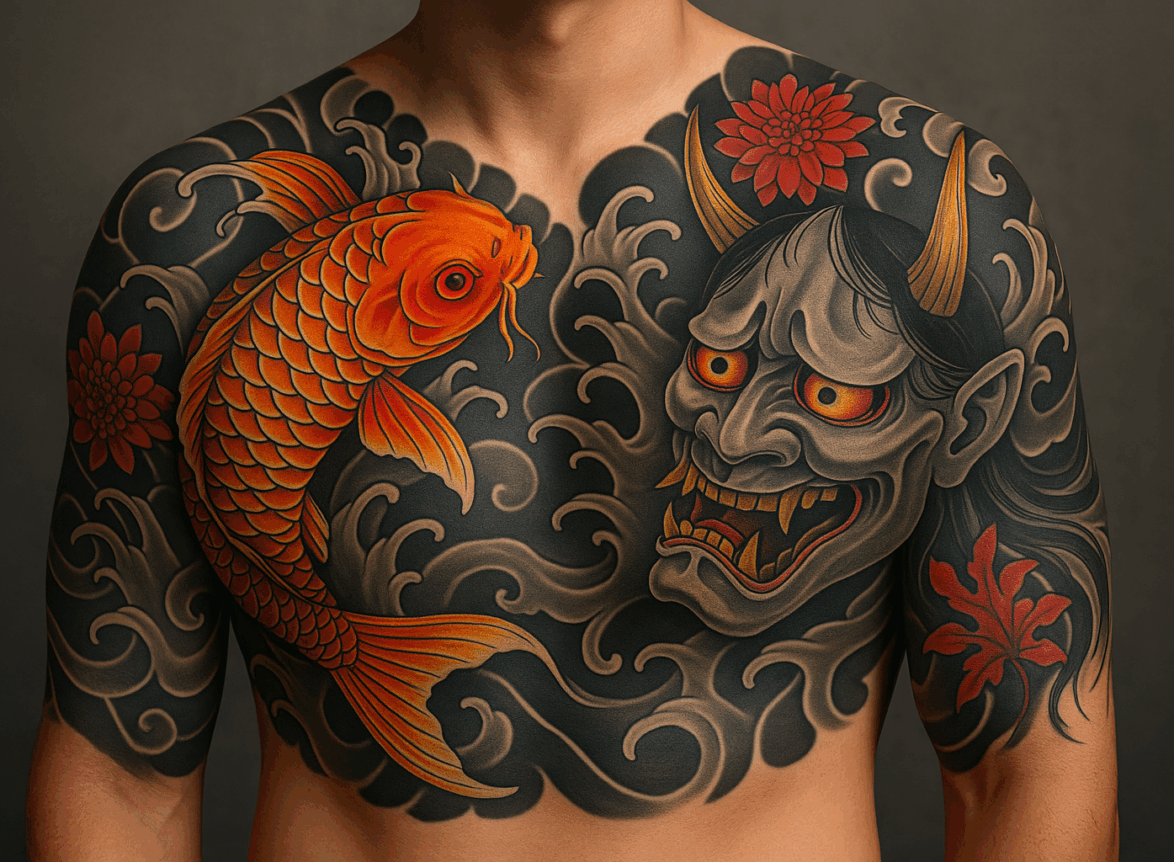When a geisha appears in traditional Japanese tattoo art, she arrives adorned with more than beauty. Every element she carries — her fan, her kimono, and her hair — serves as a layered symbol. These details, often overlooked by casual observers, are what turn an image into a cultural spell etched in ink.
In this post, we break down the symbolic meaning of these key geisha elements and how they function within irezumi, the traditional Japanese tattooing style.
1. The Fan (Sensu or Ogi): Gesture, Concealment, Power
What It Is: A folding fan or open fan used in traditional Japanese dance and court rituals. In tattoo art, it often appears held to the lips, in front of the face, or open in motion.
Symbolic Meanings:
- Control over expression: Fans conceal emotion, suggesting restraint or unspoken knowledge
- Seduction through subtlety: A fan hides more than it reveals, enhancing mystery
- Artistic command: Used in geisha performances, the fan is an extension of the body’s language
Tattoo Context:
- Fans placed near the face = emotional guardedness or inner mystery
- Fans in motion = narrative flow, transformation, or ritual performance
- Broken fans = lost identity, sorrow, or shattered illusions
2. The Kimono: Armor of Discipline and Identity
What It Is: A traditional layered garment worn by geisha in performance and ceremony. Kimonos in tattoos are often rich with patterns, folds, and movement.
Symbolic Meanings:
- Discipline and formality: The kimono must be worn properly and elegantly
- Social signaling: Color, pattern, and style indicate status, season, and emotional tone
- Boundary and protection: The layers create distance, maintaining an emotional perimeter
Tattoo Context:
- Flowing kimono = grace under pressure; the ability to move within restriction
- Patterned with cranes, waves, or florals = encoded messages of longevity, resilience, or femininity
- Kimono slipping from the shoulder = intimacy, vulnerability, or transformation
3. The Hair: Poise, Class, and Emotional Language
What It Is: Elaborately styled in buns or waves, adorned with kanzashi (ornamental hairpins). The hairstyle itself reveals status.
Symbolic Meanings:
- Composure and self-mastery: Hours of preparation go into achieving this form
- Class distinction: Simpler styles = geisha; elaborate with many pins = oiran (courtesan)
- Encoded emotion: A few loose strands may suggest rebellion or unraveling
Tattoo Context:
- Tidy, pinned hair = serenity, social control, emotional containment
- Hair mid-motion = defiance, dance, breaking from form
- Ornament-heavy hair = potential mislabeling as oiran (requires historical accuracy)
Combined Symbolism in Tattoo Art
When these elements are composed together in a geisha tattoo, they tell a deeper story:
- A geisha holding a fan to her lips, kimono tightly wrapped, hair pinned: the sovereign woman, silent but all-seeing
- A geisha with one shoulder bare, fan in motion, hair strands loose: rebirth, grief, or erotic agency
- A geisha amid cherry blossoms, with a flowing kimono and open fan: acceptance of impermanence and beauty as ritual
These details matter. They signal whether the tattoo respects the archetype or flattens it.
Why Tattoo Artists Must Understand These Symbols
Any tattoo artist working with Japanese motifs must understand these layers. Otherwise, the geisha risks becoming a decorative trope rather than a cultural emblem of grace, strength, and encoded emotion.
Ask your artist:
- Do they know the symbolism behind the fan?
- Can they explain why the kimono is patterned a certain way?
- Do they understand the difference between a geisha and an oiran?
These questions matter when your skin becomes the canvas.
Final Thought: The Language of Details
Geisha tattoos don’t shout. They whisper, in movements of silk, shadows of hair, and folds of fabric. The fan, kimono, and hair aren’t just ornamental—they’re spoken language. They tell a story about restraint, agency, and identity under pressure.
If you choose to wear her, choose to know her.
Because every line drawn is a word spoken. And every detail carries meaning.




Leave a comment
Your email address will not be published. Required fields are marked *
You must be logged in to post a comment.